Monarch Butterfly
Danaus plexippus
During migration, Monarch Butterflies may travel 250 or more miles each day.
Advertisement
Monarch Butterfly Scientific Classification
- Kingdom
- Animalia
- Phylum
- Arthropoda
- Class
- Insecta
- Order
- Lepidoptera
- Family
- Nymphalidae
- Genus
- Danaus
- Scientific Name
- Danaus plexippus
Read our Complete Guide to Classification of Animals.
Monarch Butterfly Conservation Status
Monarch Butterfly Facts
- Name Of Young
- Larvae/Caterpillar
- Group Behavior
- Group
- Fun Fact
- During migration, Monarch Butterflies may travel 250 or more miles each day.
- Biggest Threat
- Habitat loss
- Most Distinctive Feature
- Black, orange, and white pattern on wings
- Other Name(s)
- Milkweed, Black Veined Brown, Common tiger, Wanderer
- Gestation Period
- 3 to 8 days for eggs to hatch after they are laid
- Litter Size
- 290 to 1180 eggs (in a lifetime)
- Habitat
- Sunny places with streams, vegetation, and few predators (wintering habitat)
- Predators
- Birds (including robins, cardinals, sparrows, pinyon jays, and orioles), mice, Chinese Mantis, Asian Lady Beetle
- Diet
- Herbivore
- Lifestyle
- Diurnal
- Favorite Food
- Milkweed plants (larvae); thistles, Indian hemp, alfalfa, lilac, red clover, milkweeds, asters, and other plants with nectar (adults)
- Common Name
- Monarch Butterfly
- Number Of Species
- 3
- Location
- Southern Canada through Northern South America, Mexico, Hawaii, Cook Islands, Bermuda, New Zealand, Papua New Guinea, Australia, the Solomon Islands, New Caledonia, the Canary Islands, Madeira, Gibraltar, North Africa, and the Philippines
- Group
- Invertebrates
View all of the Monarch Butterfly images!
The food a Monarch eats as a caterpillar will provide the fuel for their migration as an adult butterfly.
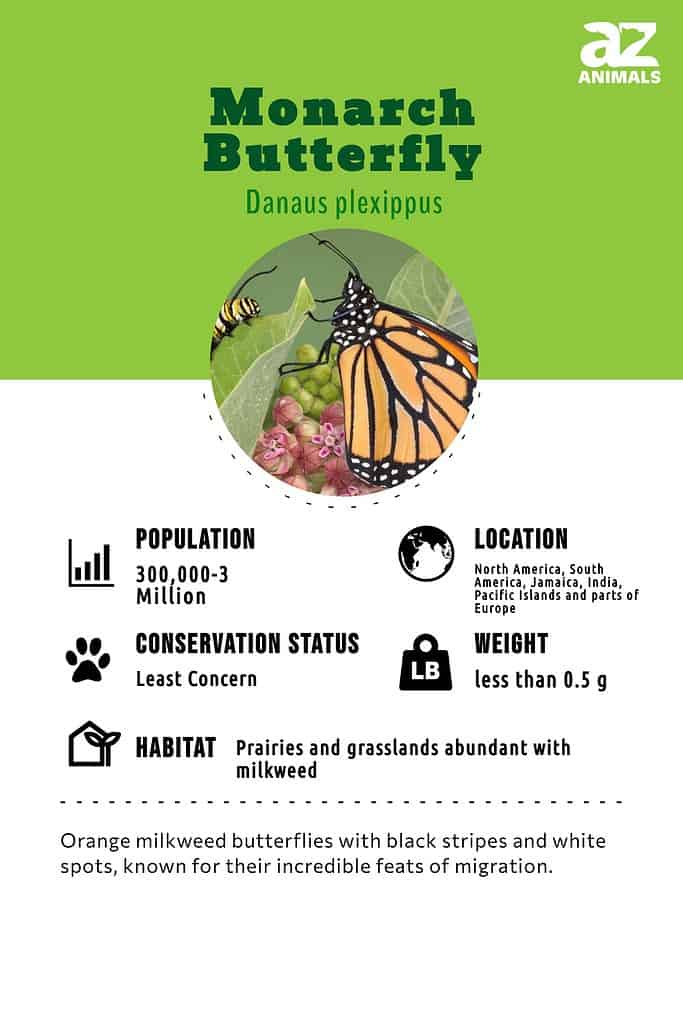
Monarch Butterflies are known for their very distinct orange, black, and white coloring. These amazing creatures go through four stages in their life cycle: egg, larvae, pupa, and adult. While some adult monarch butterflies may only live for two to six weeks, during migration they can live for eight or nine months. When they migrate in the fall, a Monarch Butterfly will travel thousands of miles. And, while they fly on their own during the day, they will form large groups, known as roosts, at night.
Incredible Monarch Butterfly Facts!

Monarch butterflies can travel 50-100 miles per day during their extensive migration.
©Dotted Yeti/Shutterstock.com
• The four stages in the life cycle of a Monarch Butterfly are egg, larvae, pupa, and adult.
• Monarchs have black, orange, and white coloring which makes them easy to identify.
• During migration, Monarchs may fly thousands of miles.
• Losing their habitats is one of the biggest threats faced by Monarchs.
• Female Monarchs lay their eggs on milkweed plants.
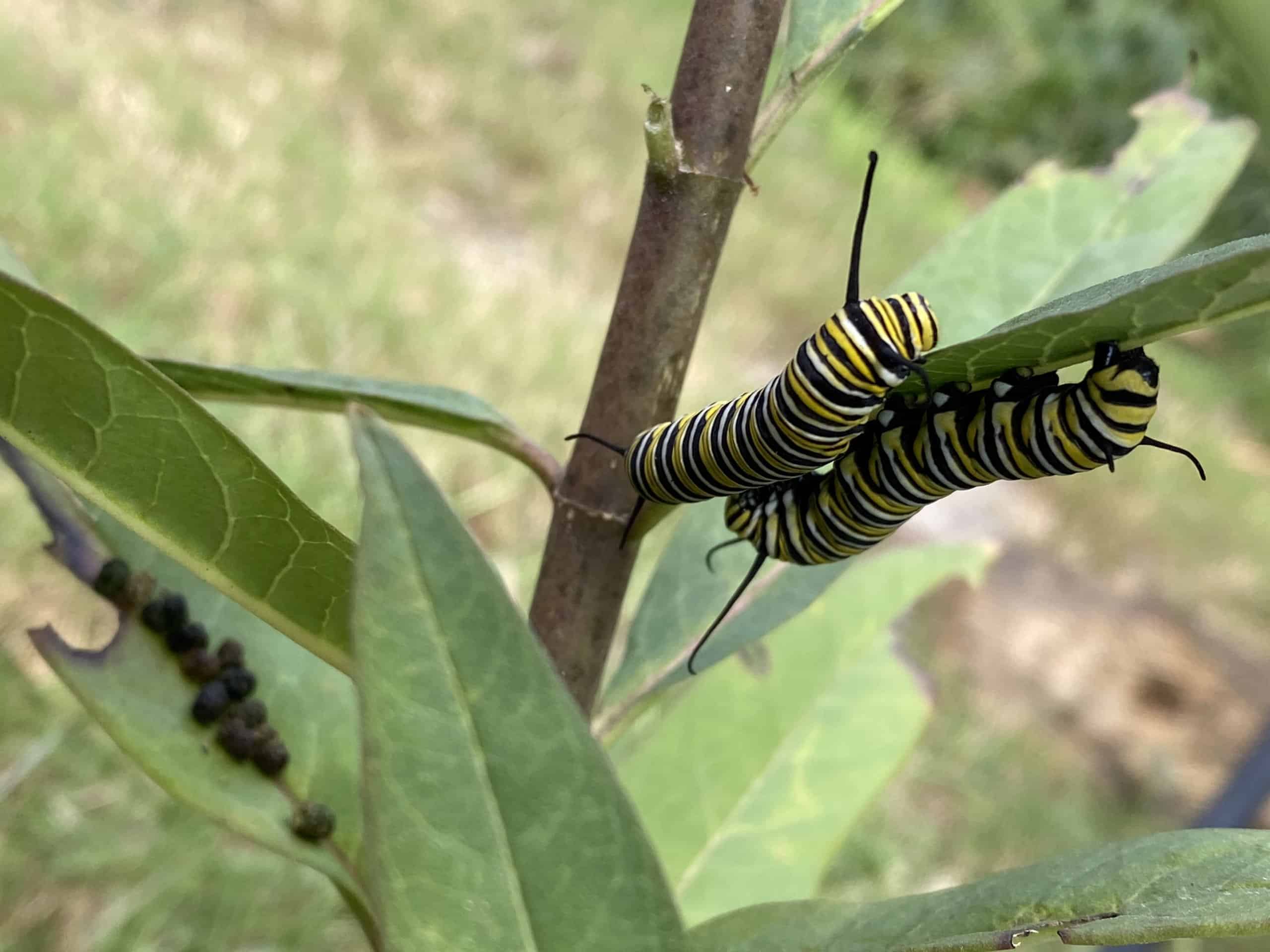
Image: Ashley Haugen
Scientific Names and Types of Monarchs
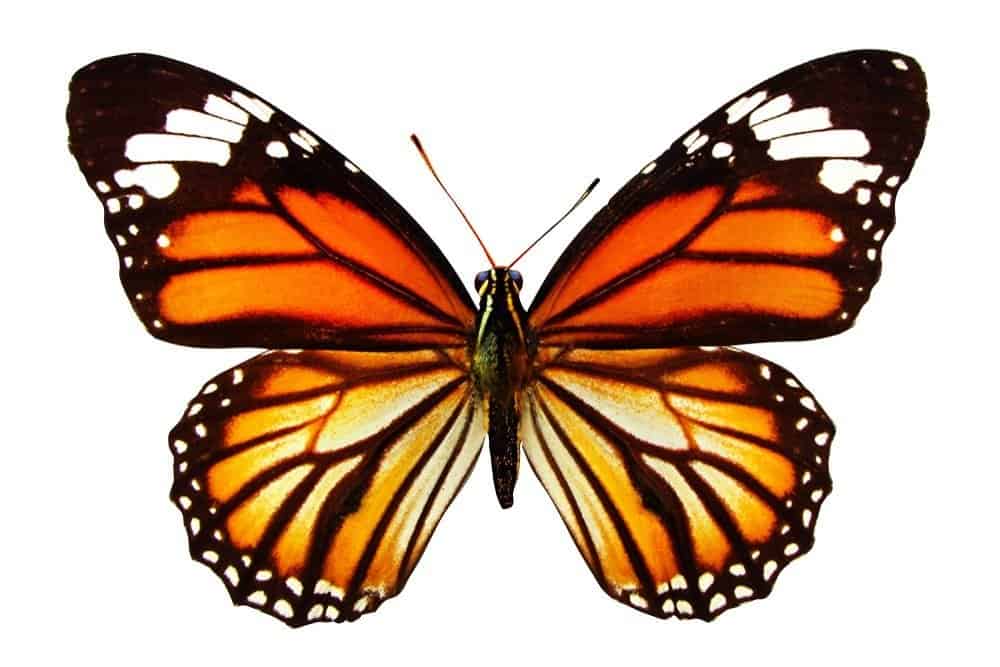
Monarchs are divided into three different subspecies based on their region.
©Vladimirkarp/Shutterstock.com
Monarch Butterflies are in the Insecta Class and belong to the Nymphalidae Family. Their scientific name is Danaus plexippus. Danaus refers to a genus of butterflies and plexippus refers to the specific Monarch Butterfly species.
There are three species of Monarch Butterflies. In addition to Danaus plexippus plexippus (the North American Monarch Butterfly), the other two species are Danaus erippus (the Southern Monarch Butterfly) and Danaus cleophile jamaicensis (the Jamaican Monarch Butterfly).
Appearance and Behavior
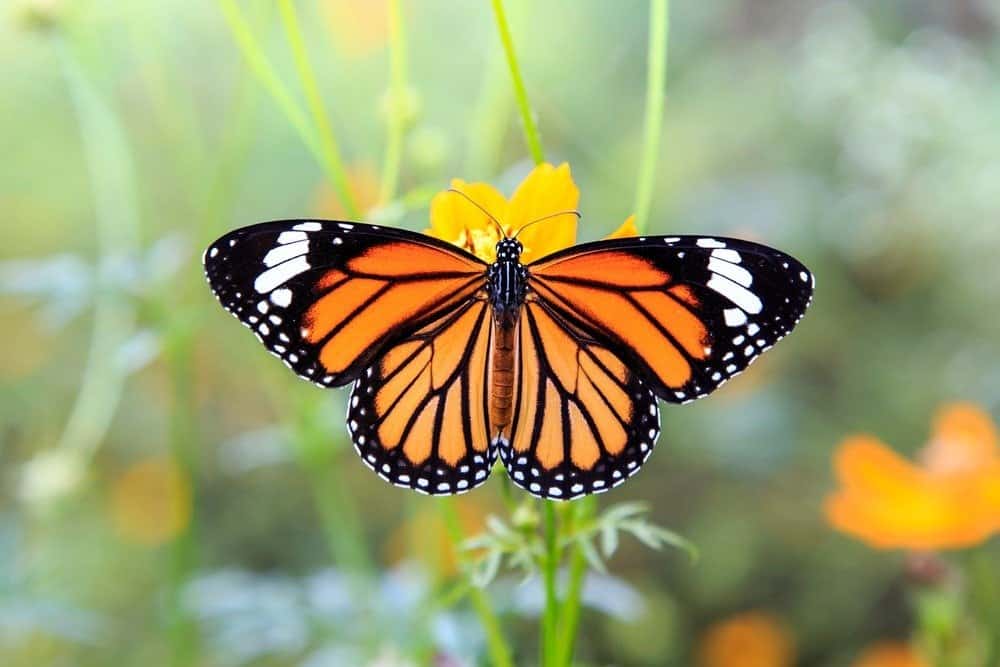
Monarch butterflies are pollinators that help flowers reproduce.
©CHAINFOTO24/Shutterstock.com
Monarch Butterflies have a very distinct appearance which makes them easy to identify. The top portion of their wings is orange with black veins, numerous white spots around the perimeter of the wings, and a few orange spots near the tips of the wings. The underside of a Monarch Butterfly’s wings looks similar to the upper side. However, instead of being a bright orange color, the wings are more of a yellow-brown color. The white spots on the undersides of their wings are larger than the ones found on the upper sides.
Throughout the migration season, the wings of different Monarch Butterflies may have a different appearance. Towards the beginning of the migration, a Monarch’s wings look to be longer and redder than those of Monarchs migrating later in the season. Additionally, the wings of Monarchs who migrate and those who do not also have slight differences.
A Monarch Butterfly’s wingspan is between 3.5 and 4 inches wide, this is as wide or a little wider than the average width of an adult male’s hand.
California Tortoiseshell Butterflies, Painted Lady Butterflies, Western Tiger Swallowtail Butterflies, Viceroy Butterflies, and Queen Butterflies all may be confused for Monarchs because of their similar coloring. All of these butterflies, along with Monarchs, have bright colors on their wings which serve to warn predators that they are toxic and should not be eaten.
Monarch Butterflies are active during the day. North American Monarchs migrate north and south each year. They may travel thousands of miles for their migration. When migrating, they fly alone, however, at nightfall, they come down to form a large group with other Monarchs known as a roost or a bivouac. Roosts are often found in trees that will offer the butterflies shelter to offer them protection from predators and the elements. They will also be located near a nectar source.
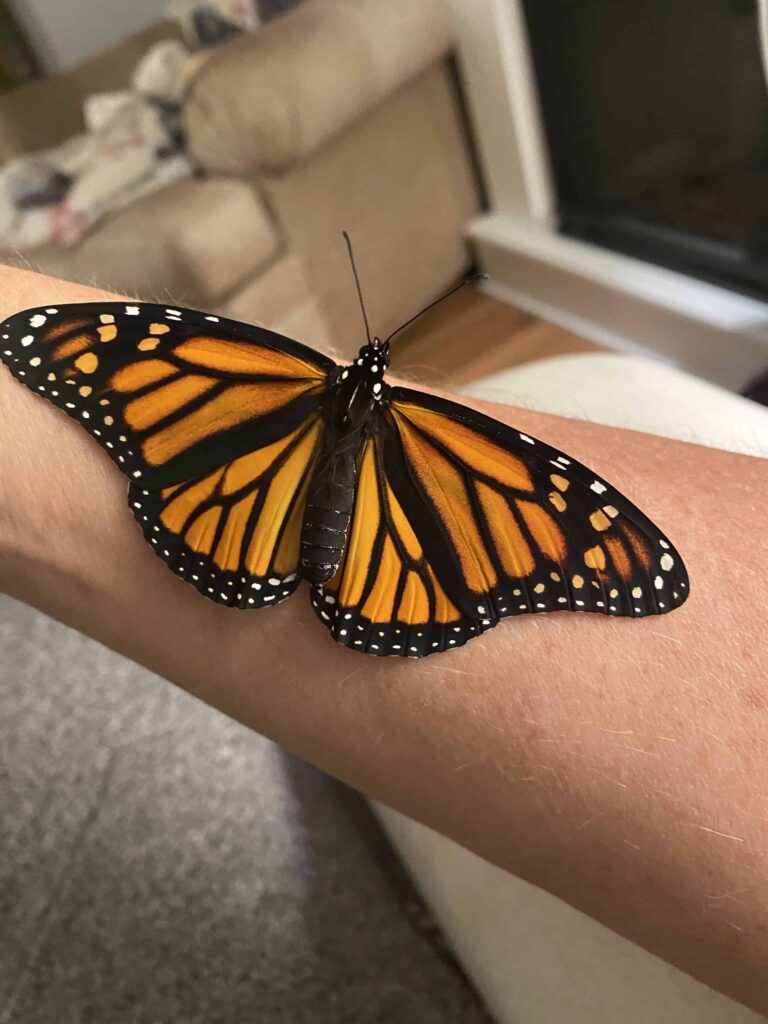
Habitat
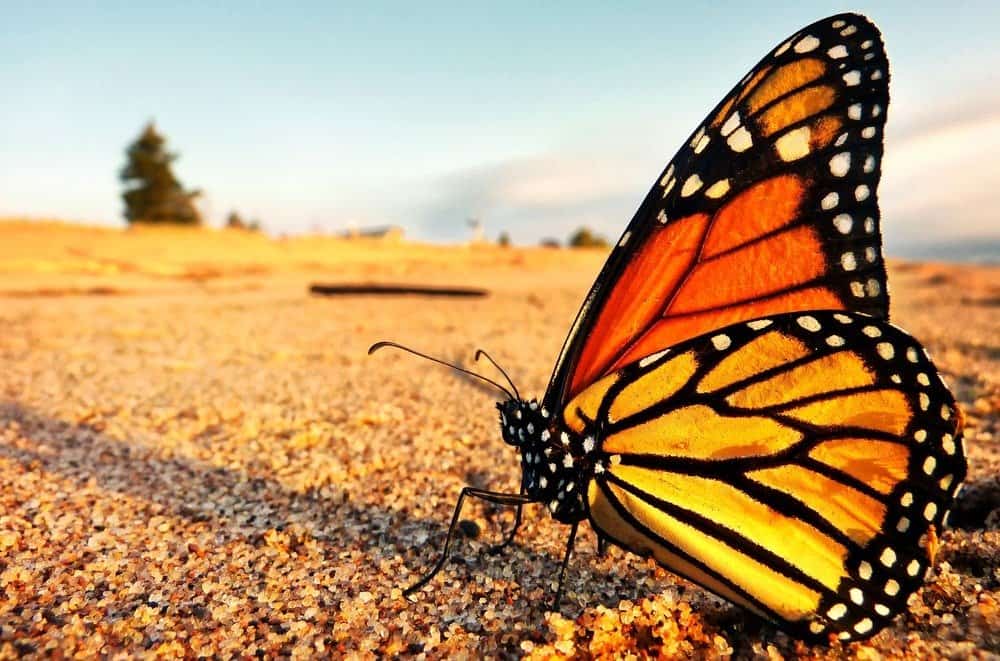
A monarch butterfly takes a well deserved break on the shores of Lake Superior in Minnesota on its northward return to Canada from Mexico.
©Chris Frost/Shutterstock.com
The North American Monarch Butterfly, Danaus Plexippus Plexippus, can be in different areas across the continent. There are both western and eastern populations of this species. Monarchs can be found between southern Canada and norther South America. This species also has been spotted in various islands including Bermuda, the Cook Islands, Hawaii, Australia, New Zealand, Papua New Guinea, the Canary Islands, and the Solomon Islands.
Overwintering groups of Monarch Butterflies have also been found in Florida, Arizona, California, and Mexico. When choosing an overwintering location, Monarchs look for a habitat that will provide them with access to streams, abundant sunlight, and vegetation. They also choose areas that do not have many predators.
When overwintering, Monarchs may stay on different plants or tress, such as elms, locusts, oaks, sumacs, basswoods, cottonwoods, or mulberries. When Monarchs are breeding, their habitats generally consist of trees, gardens, and residential areas. When breeding, finding an area with larval host plants where they can lay their eggs is important to the butterflies.
Evolution
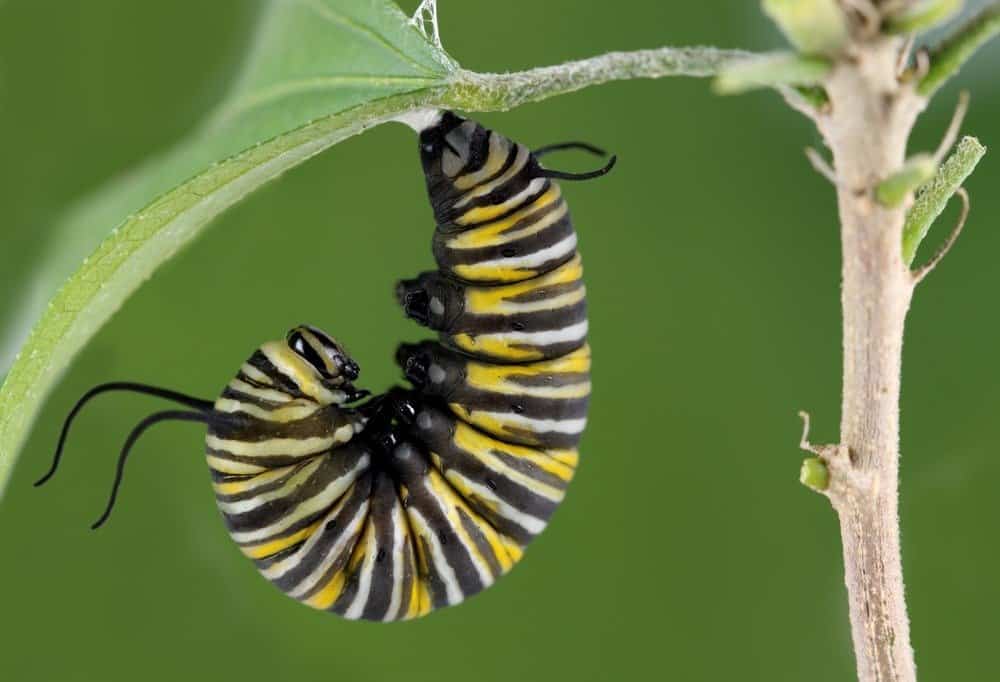
Monarchs begin eating toxic plants as a caterpillar so that they will be poisonous to predators as butterflies.
©Brandon Alms/Shutterstock.com
Monarchs have developed a wide array of evolutionarily beneficial traits throughout the course of their existence. Scientists believe that monarchs originated in North and South America and migrated elsewhere some time thousands of years ago. Recent genetic studies have revealed that the monarch’s complex migratory abilities were stored in just one gene, so that these populations that once migrated a great distance across vast oceans to arrive in a new habitat stopped expressing this gene once they had settled down.
Monarchs have also adapted a resistence to toxic plants that they ingest in order to fend off predators. This is the reason why monarchs are considered poisonous, though the amounts of toxin present in their bodies are not high enough to harm humans or do significant damage to animals like cats and dogs.
Diet
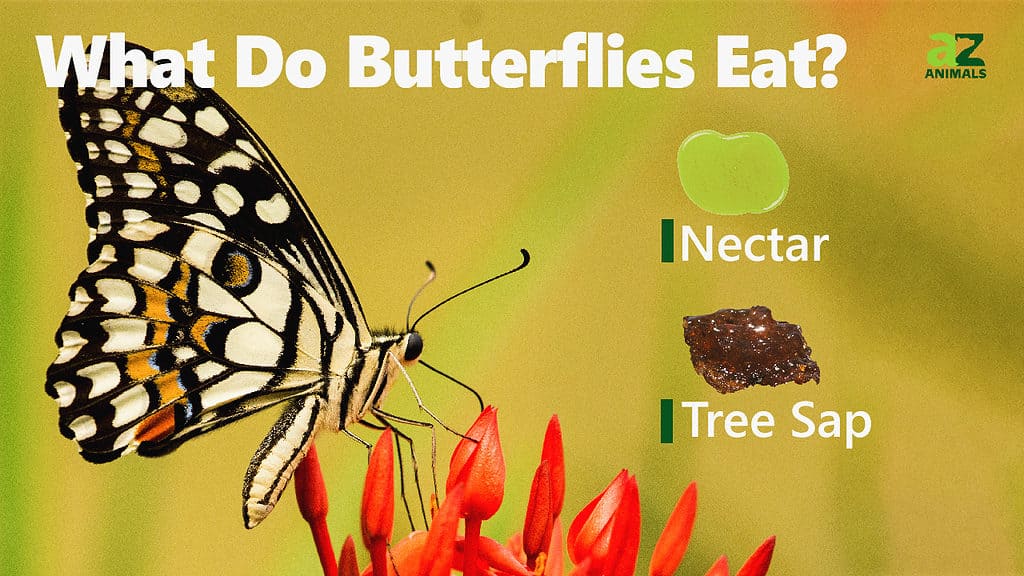
The diet of Monarch Butterfly larvae, or caterpillars, differs significantly from that of adult Monarch Butterflies. Monarch lay their eggs on plants that the larvae will be able to eat after hatching. These host plants include California milkweed, woolly pod milkweed, poke milkweed, swamp milkweed, Arizona milkweed, butterfly weed, whorled milkweed, Caribbean milkweed, rush milkweed, and showy milkweed.
Adult Monarch Butterflies enjoy nectar from a variety of different plants. Some of these plants include milkweeds, teasel, coneflowers, alfalfa, lilac, tail ironweed, wild carrot, dame’s rocket, and Indian hemp. Monarchs also engage in mud-puddling, which is a behavior they use to get moisture and minerals from wet gravel and damp soil.
Predators and Threats
There is fear that the Monarch Butterfly may be increasingly threatened due to declining population numbers. As of 2014, the number of Monarch Butterflies that could be found west of the Rocky Mountains had declined by more than 90% since 1995. Another study released in February of 2015 by the U.S. Fish and Wildlife Service showed that almost one billion monarchs had disappeared from their overwintering locations since 1990.
One threat that has led to a decline in the number of Monarch Butterflies is loss of their habitats caused by the use of herbicides. Species of milkweed plants, where the Monarchs lay their eggs and drink nectar, have been decreasing. Between 120 and 150 million acres of milkweed in the Midwest have been eliminated.
Another threat faced by Monarchs is being killed by car strikes. According to a 2019 study in northern Mexico, it was estimated that 200,000 Monarchs were killed by vehicle strikes each year in just two different ‘hotspot’ locations.
In addition to these human-based threats to Monarch butterflies, they also have some natural predators. However, their natural predators do not pose the same threat to the overall population of the butterflies that human-made causes do.
Even though many Monarchs in both the larvae and adult stages are toxic to many species, there are a few birds who have learned which parts are safe to eat. Some other birds have acquired different capabilities of identifying which parts of the Monarchs are safe to eat or unsafe based on the taste. Robins, sparrows, pinyon jays, orioles, thrashers, and some other birds pretty on larvae and adult Monarchs.
Other natural predators include mice, the Chinese Mantis, the Asian Lady Beetle, and Wasps
Currently, Monarch Butterflies are not listed as an endangered or protected species. However, many scientists and others are concerned about Monarch Butterflies and their declining numbers. A review of their status was initiated by the U.S. Fish and Wildlife Service in 2015. A decision about whether to upgrade their status is expected in December of 2020.
Reproduction and Life Cycle

Monarchs begin their lives as tiny white eggs.
©iStock.com/SherryL18
Male and female monarch butterflies usually mate several times. The more times they mate, the more eggs females will lay. Monarchs in overwintering populations typically mate in the spring. Unlike other butterfly species, Monarchs are not as dependent on pheromones for mating.
When looking for a mate, male Monarchs will find a female, follow her, and may even force her down to the ground. Once on the ground, the male and the females will often copulate and will stay attached to each other for between 30 and 60 minutes. However, not all mating attempts result in copulation. When a male and female Monarch copulate, the male transfers both sperm and spermatophore to the female. The spermatophore gives additional nutrition to the female to help her lay more eggs.
Different factors can affect the size of the eggs a female will lay. Smaller females and those who are older typically lay smaller eggs than larger or younger adult females. Because females mate more than once, they may lay anywhere between 290 and 1180 eggs throughout the course of their life.
There are four stages in the life cycle of a Monarch Butterfly: egg, larvae, pupa, and adult. Adult Monarchs lay their eggs on the underside of a leaf of a host plant, such as milkweed. The eggs are most often laid during spring and summer. Monarch eggs are very small. They are only about 1.2 x 0.9 millimeters and weigh less than .5 milligrams. The eggs are oval-shaped and eight light green or cream-colored. Once laid, the eggs will take between 3 and 8 days to finish developing. At that point, they will hatch.
The next stage in the life cycle of a Monarch Butterfly is the larvae stage. More commonly referred to as caterpillars, larvae go through five different stages of growth. They start at just 2 to 6 millimeters in length, and by the end of the fifth stage, they are around 4.5 centimeters long. Between each of these stages, the caterpillar molts its skin. As the larvae progress through the five stages, they develop a distinctly white, yellow, and black striped pattern. During the fifth stage, the larvae eat a lot. By the end of the stage, they will have increased their weight by 2,000 times from when they first emerged from the leaf.
Next, the larvae prepare for the third stage in the life cycle, which is the pupa stage. The caterpillar spins a silk pad where it can hang upside down. They attach themselves to their pad and form a J-shape. They stay in this J-shape for 12 to 16 hours, after which time the caterpillar goes into peristalsis. The skin behind their head splits, and they shed their skin. This leaves a green chrysalis or pupa. Over time, the chrysalis hardens and becomes less fragile. Inside the chrysalis, the adult butterfly forms. Shortly before the Monarch is ready to emerge from the pupa, the chrysalis will become translucent and eventually transparent.

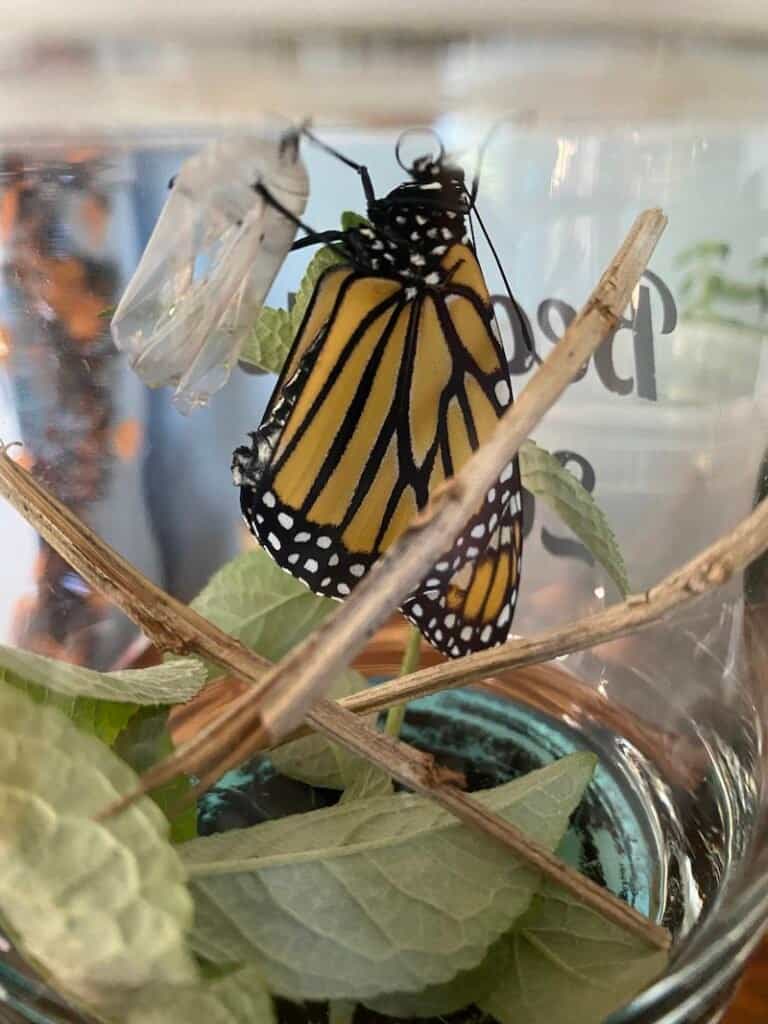
Monarchs stay in the pupa stage for around two weeks. Once they emerge, they will initially hang upside down to allow their wings to dry. The wings will dry out, stiffen, and expand when the butterfly pumps fluids into them. Once able to fly, the butterfly will find nectar to feed on. Adult Monarch Butterflies reach sexual maturity during the breeding season by the time they are four to five days old. Migrating Monarchs will not reach sexual maturity until overwintering is finished, however.
During the breeding season, most Monarch Butterflies live between two and five weeks. The last generation of the season that migrates can live for up to nine months.
Monarch Butterfly Population

Monarch Butterflies have been on the verge of being classified as endangered for many years.
©Noradoa/Shutterstock.com
Even though Monarch Butterflies are not listed as endangered, their numbers have been decreasing due to threats such as habitat loss. There are currently less than 30,000 Danaus plexippus plexippus (North American Monarch Butterflies) left.
View all 164 animals that start with MMonarch Butterfly FAQs (Frequently Asked Questions)
Are Monarch Butterflies carnivores, herbivores, or omnivores?
Monarch butterflies are herbivores; they get their nutrients from plants.
Where do Monarch butterflies live?
North American Monarch Butterflies are found in many different areas across the continent of North American. Populations exist in both the eastern and western parts of North America. They can also be found on many islands including Australia, New Zealand, Hawaii, Bermuda, and the Canary Islands.
How long do Monarch butterflies live?
During the breeding season, Monarch Butterflies will live for between two and six weeks. During migration, they can live for up to nine months.
What do Monarch butterfly eggs look like?
Monarch Butterfly eggs are very small at just about 1.2 by 0.9 millimeters. The eggs are either light green or cream-colored and have a conical shape.
Are Monarch butterflies rare?
While Monarch Butterflies are not currently considered endangered, their numbers have been decreasing over the past several years. It is estimated that there are only around 30,000 Monarchs.
How big is a Monarch butterfly?
Monarch Butterflies have a wingspan that is between 3.5 and 4 inches.
How long does the life cycle of the Monarch Butterfly take?
It takes about 30 days from the time an egg is laid until an adult butterfly emerges from the chrysalis.
How many eggs can a Monarch Butterfly lay?
During her life, a female Monarch Butterfly will lay between 290 and 1180 eggs.
Do Monarchs hibernate?
Yes, Monarchs hibernate for between six and eight months. Depending on where Monarchs migrate from, they may either hibernate in Mexico or California over the winter months.
What Kingdom do Monarch Butterflies belong to?
Monarch Butterflies belong to the Kingdom Animalia.
What phylum do Monarch Butterflies belong to?
Monarch Butterflies belong to the phylum Arthropoda.
What class do Monarch Butterflies belong to?
Monarch Butterflies belong to the class Insecta.
What family do Monarch Butterflies belong to?
Monarch Butterflies belong to the family Nymphalidae.
What order do Monarch Butterflies belong to?
Monarch Butterflies belong to the order Lepidoptera.
What type of covering do Monarch Butterflies have?
Monarch Butterflies are covered in Scales.
What are some predators of Monarch Butterflies?
Predators of Monarch Butterflies include birds (including robins, cardinals, sparrows, pinyon jays, and orioles), mice, Chinese mantis, and Asian Lady Beetles.
What is the scientific name for the Monarch Butterfly?
The scientific name for the Monarch Butterfly is Danaus plexippus.
How many species of Monarch Butterfly are there?
There are 3 species of Monarch Butterfly.
What is a baby Monarch Butterfly called?
A baby Monarch Butterfly is called a larva or caterpillar.
What is the biggest threat to the Monarch Butterfly?
The biggest threat to Monarch Butterflies is habitat loss.
What is another name for the Monarch Butterfly?
The Monarch Butterfly is also called the milkweed, black veined brown, common tiger, or wanderer.
What is an interesting fact about Monarch Butterflies?
During migration, Monarch Butterflies may travel 250 or more miles each day.
How fast is a Monarch Butterfly?
A Monarch Butterfly can travel at speeds of up to 12 miles per hour.
How do Monarch Butterflies have babies?
Monarch Butterflies lay eggs.
What is the difference between a monarch butterfly and a queen butterfly?
The key differences between a queen butterfly and a monarch are their courtship behavior, temperament, morphology, and flying speed.
Although they are so much alike, the queen butterfly has white spots on its hind wings that distinguish it from the monarch. You can easily tell the two species apart when their wings are open..
What is the difference between a male and a female monarch butterfly?
The most visible differences between male and female monarchs are in their morphology and behavior. Although male monarchs tend to be bigger than females, you may be unable to identify the sex of any butterfly unless it is in the company of others.
Thank you for reading! Have some feedback for us? Contact the AZ Animals editorial team.
Sources
- Wikipedia, Available here: https://en.wikipedia.org/wiki/Monarch_butterfly
- Thought Co, Available here: https://www.thoughtco.com/the-six-basic-animal-groups-4096604
- WWF, Available here: https://www.nathab.com/articles/mexico-central-america/monarch-butterflies/5-fascinating-facts/#:~:text=A%20monarch%20butterfly%20can%20flap,will%20speed%20it%20up%20considerably.
- U.S. Forest Service, Available here: https://www.fs.fed.us/wildflowers/pollinators/Monarch_Butterfly/faqs.shtml#:~:text=Monarch%20butterflies%20typically%20live%20from,to%208%20to%209%20months.
- Deschutes Land Trust, Available here: https://www.deschuteslandtrust.org/news/blog/2019-blog-posts/butters-similar-to-monarchs
- Farmers' Almanac, Available here: https://www.farmersalmanac.com/monarch-butterfly-facts-32092
- Monarch Watch Biology, Available here: https://www.monarchwatch.org/biology/cycle1.htm#:~:text=Butterflies%20and%20moths%20undergo%20complete,completed%20in%20about%2030%20days.&text=Monarchs%20usually%20lay%20a%20single,the%20top%20of%20the%20plant.

















